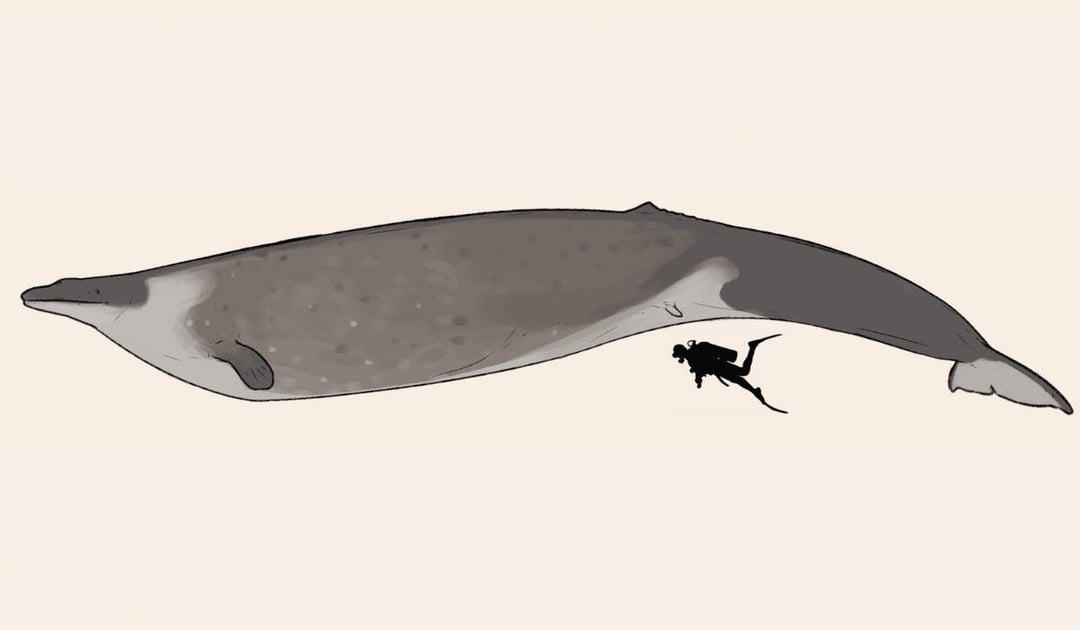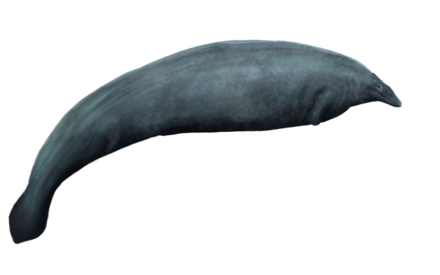This perfect lad is Perucetus Colossus, a newly discovered 39-37 million year old fossil of an extinct whale that was even heavier than todays blue whale.

Look at that tiny head, remarkable.
[Wikipedia:]
Perucetus is an extinct genus of early whale from the Eocene of Peru. With an estimated length exceeding 17.0–20.1 meters (55.8–65.9 ft) and weight ranging from 85–340 t (84–335 long tons; 94–375 short tons), Perucetus may have rivalled, if not exceeded, the modern blue whale in weight. This is in part due to the incredibly thick and dense bones this animal possessed, coupled with its already great size. The ecology of Perucetus, however, remains largely mysterious. Based on the fossils, it was likely a slow-moving inhabitant of shallow waters. Its diet can only be speculated upon, but one suggestion proposes that it may have fed on benthic animals like crustaceans and molluscs that live on the ocean floor. Only a single species is currently known, P. colossus.
The most characteristic feature of Perucetus is the high degree of pachyosteosclerosis present in the bones of the body, which means that the bones are simultaneously thicker (pachyostotic) and denser (osteosclerotic) than in any other known cetacean. Due to pachyostosis, the vertebrae are greatly inflated, making them nearly twice as voluminous as those of a 25 m (82 ft) long blue whale. The increase in bone mass is also observed in the microanatomy of the bone. The ribs are entirely composed of dense bone and lack the medullary cavity seen in the bones of other animals. The vascular channels that penetrate the bone are narrow, not only indicating the maturity of the animal but also adding to the already dense nature of the bones.
Perucetus may have ranged in weight from 85–340 t (84–335 long tons; 94–375 short tons) with an average of 180 t (180 long tons; 200 short tons). The 17–20-meter (56–66 ft) skeletal structure alone would have accounted for 5.3–7.6 t (5.2–7.5 long tons; 5.8–8.4 short tons), which is already two to three times the weight of the skeleton of a 25 m (82 ft) long blue whale. The weight estimates are based around the relation between skeletal and total body mass of modern mammals. Notably, whales have much lighter skeletons compared to their total mass, whereas sirenians (dugongs and manatees) are similar to land mammals in having much denser skeletons that contribute more to their total weight. Bianucci and colleagues note the difficulties in determining the weight of basilosaurids. They suggest that the increase in skeletal mass could have been compensated for by larger amounts of blubber, which is less dense than other soft tissue. Ultimately, extreme values were used in the calculations, leading to the wide range for the weight estimate present in the type description. Basing the math on sirenians, a weight of 85 t (84 long tons; 94 short tons) was calculated. Combining the lowest skeletal-weight–to–total-weight ratio found in cetaceans with the highest estimated skeletal mass yields a weight of up to 340 t (330 long tons; 370 short tons). Mean values, on the other hand, result in a weight of 180 t (180 long tons; 200 short tons). This may indicate that, although not as long, the species could have been heavier than modern blue whales.
The immense size and bone density both make it impossible for Perucetus to have gone on land, which is in line with its classification as a basilosaurid. The pachyosteosclerosis is taken as a sign that Perucetus lived in shallow waters, using it as buoyancy control as modern manatees do. Given its size and weight, Perucetus could have resisted crashing waves in more turbulent waters, something inferred for the similarly buoyant Steller's sea cow. The animal's affinity for shallow waters is congruent with the interpretation that basilosaurids preferred coastal waters, rather than living in the open ocean.
While the fragmentary nature of this animal renders precise statements on its locomotion uncertain, some suggestions have been made. The elongated centra of the vertebrae for instance may suggest that it, like manatees but not dugongs, swam with the use of axial undulation. This further indicates shallow waters rather than pelagic habitats for the animal. The great size of the vertebrae does impose limits on the swimming style of Perucetus, as does the shape of the transverse processes of the vertebrae. Using the methods of a previous study would suggest that Perucetus was limited in its ability to flex upwards and from side to side but possessed an increased ability to flex downward (ventrally). This could suggest that Perucetus swam with slow up and down movements of its tail while not making use of any side to side movements as has been suggested for Basilosaurus. The strong ventral flexion in particular may have been of great importance for the animal when pushing itself off the ocean floor in order to breathe at the surface. The precise function of this combination of pachyosteosclerosis and gigantism is not fully understood, but may be linked to the energetic cost of undulating movements or the ability to dive for longer periods of time.
The diet and feeding style remain even more mysterious, since no skull material of this animal is currently known. Still, some possibilities can be inferred based on the lifestyle deduced from the postcrania. While the many noted similarities to sirenians could be taken as a sign of a grazing lifestyle, this notion is deemed unlikely, as no other cetacean is known to have been herbivorous. It is deemed more likely that Perucetus fed on molluscs, crustaceans and other animals on the sea floor, either through suction feeding or filter feeding. Such a lifestyle would be comparable to that of the modern grey whale. Another hypothesis mentioned by Bianucci et al. is that Perucetus could have been a scavenger like large demersal sharks. Ultimately, until better material is found, the precise ecology of Perucetus will remain unknown.

My new favorite extinct animal. No one steal him, hes my new best friend.


very cool that it was found in the desert, makes u think